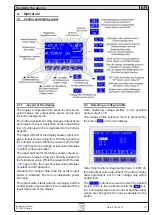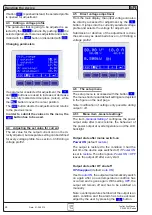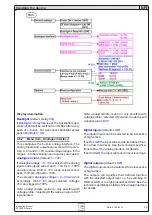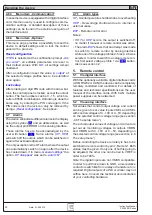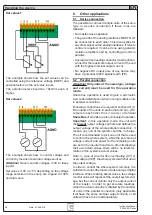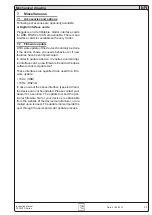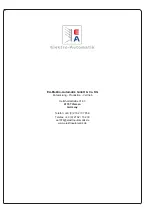
30
EN
Instruction Manual
PSI 800 R Series
Date: 01-25-2016
Handling the device
4.6.3 Menu item „Communication“
In case the device is equipped with a digital interface
card, this menu entry is used to configure commu-
nication settings. A detailed description of those
settings can be found in the external user guide of
the interface card.
4.6.4 Menu item „Options“
This menu page provides a possibility to reset the
device to default settings and to lock the control
panel with a pin code.
Reset configuration
If
YES
is selected at the confirmation prompt „
Are
you sure?
“, all editable parameters are reset to
their default values. With
NO
, all settings remain
unaltered.
After a configuration reset, the value „
U output
“ of
the selected voltage profiles has to be submitted
once again.
Lock setup
After entering a 4 digit PIN code with the arrow but-
tons, the control panel is locked, except the unlock
button. The four numbers can be 0 - 15, which re-
sults in 65536 combinations. Unlocking is done the
same way, by entering the PIN code again. If the
PIN code is lost, the lock can only be removed by
doing a „
Reset configuration
“. See above.
4.7 Alarms
The device will indicate different alarms in the display
using the symbol
and an abbreviation, as well
as the output pin ERROR on the analog interface.
Those alarms have to be acknowledged by the
user with button
. Some alarms (
OT
,
OVP
)
will switch off the output, which can be switched on
again after acknowledgement.
The only exception is the OT alarm, where the output
can automatically switch on again after the device
has cooled down, if in menu „
General settings
“ the
option „
OT disappear
“ was set to „
auto ON
“.
4.7.1 Alarm types
OT
- Overtemperature shutdown due to overheating
OVP
- Overvoltage shutdown due to internal or
external cause
EXT
- Remote control error
Notes:
• If
OT
or
OVP
occurs, the output is switched off,
no matter if manual or remote control was active
• The alarm
EXT
shows that an attempt was made
to switch to remote control by analog interface
while one of the voltage profiles 2-5 resp. 2-6 was
selected. In order to switch to analog remote con-
trol, first select voltage profile 1 via
button.
Also see section 4.2.
5. Remote control
5.1 Via digital interface
With the optionally available, digital interface cards
(USB, RS232 or CAN) the device can be completely
remotely controlled and monitored. For details of
features and technical specifications see the user
manual of the interface cards. With CAN, multiple
power supplies can be networked.
5.2 Via analog interface
Set values that control output voltage and current
can be given to set value inputs VSEL and CSEL
with control voltages of 0...10V or 0...5V, depending
on the selected control voltage range (see section
„4.6 The setup menu“).
The actual output values of voltage and current are
put out as monitoring voltages to outputs VMON
and CMON with 0...10V or 0....5V, depending on
the selected control voltage range (see section „4.6
The setup menu“).
Before controlling the device remotely is has to be
switched to remote control by pin 7 „Remote“. Both
values must be given. If only one of both is going to
be adjusted, the other one can be tied to VREF in
order to be 100%.
Note: the digital inputs are not CMOS compatible.
In order to pull those down to GND, a low-resistive
contact or switch like from a relay or transistor etc. is
required. Digital outputs of a PLC or similar may not
suffice here. Consult the technical documentation
of your controlling hardware.












